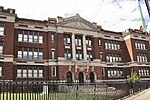Afro-American Historical and Cultural Society Museum

The Afro-American Historical and Cultural Society Museum is located is on the upper floor of the Greenville Branch of the Jersey City, New Jersey Public Library, its collection is dedicated to the African American experience. The museum has galleries for lectures, special exhibits, and a permanent collection of material culture of New Jersey's African Americans as well as African artifacts. The collection includes books, newspapers, documents, photographs and memorabilia regarding African American history and information about the slave trade in New Jersey, the underground railroad, a replica of an urban 1930s kitchen, the Pullman Porters (a black labor union), the Civil Rights Movement, the NAACP in New Jersey, New Jersey"s historic African American churches, and genealogical records. The heritage of Jersey City's African American community has been collected and preserved in a special collection, including the city's earliest black residents (in the 17th century Bergen, New Netherland settlement), its role in the Underground Railroad, and the civil rights movement, including Martin Luther King Jr.'s appearances.
Excerpt from the Wikipedia article Afro-American Historical and Cultural Society Museum (License: CC BY-SA 3.0, Authors, Images).Afro-American Historical and Cultural Society Museum
John F. Kennedy Boulevard, Jersey City
Geographical coordinates (GPS) Address Nearby Places Show on map
Geographical coordinates (GPS)
| Latitude | Longitude |
|---|---|
| N 40.703055555556 ° | E -74.091388888889 ° |
Address
Jersey City Public Library: Greenville
John F. Kennedy Boulevard 1841
07305 Jersey City
New Jersey, United States
Open on Google Maps






